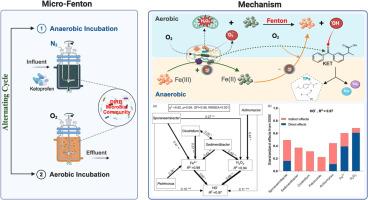环中性微生物Fenton催化:利用铁-氧化还原协同作用实现可持续药物降解
IF 12.4
1区 环境科学与生态学
Q1 ENGINEERING, ENVIRONMENTAL
引用次数: 0
摘要
酮洛芬(ketoprofen, KET)等药物污染物在水生环境中的持续存在带来了不断升级的生态和健康风险,但传统的Fenton工艺仍然受到酸性pH依赖性和不可持续的化学投入的限制。在这里,我们提出了一个受自然启发、自我维持的微芬顿(MFenton)系统,该系统利用本地兼性厌氧铁还原微生物群落,在无外源试剂的情况下,在环中性pH下实现80%的KET降解。与单菌株生物fenton模型不同,这种由群落驱动的策略利用了协同铁氧化还原循环,其中DIRB(异同化铁还原细菌)通过交替的厌氧-好氧阶段生物生成Fe(II)和H2O2,从而在pH 7.0下产生原位羟基自由基(HO˙)。通过对微生物黑箱相互作用的解码,我们发现Sporanaerobacter、Sedimentibacter、Clostridium、Petrimonas和放线菌是调控Fe2+/H2O2动力学的关键属,而UPLC-ESI-HRMS分析显示,KET的降解途径主要是侧链脱羧(生成3-乙基二苯甲酮)和酮C-C裂解(生成苯甲酸)。最重要的是,与传统的Fenton方法相比,该系统消除了pH调节需求,降低了能源需求,为低碳制药废水修复提供了可扩展的原型。我们的发现重新定义了微生物驱动的高级氧化的边界,为如何在动态环境中设计天然铁氧化还原网络以消除污染物提供了机制见解。本文章由计算机程序翻译,如有差异,请以英文原文为准。

Circumneutral Microbial Fenton Catalysis: Harnessing Iron-Redox Synergy for Sustainable Pharmaceutical Degradation
The persistence of pharmaceutical contaminants like ketoprofen (KET) in aquatic environments poses escalating ecological and health risks, yet conventional Fenton processes remain constrained by acidic pH dependency and unsustainable chemical inputs. Here, we present a nature-inspired, self-sustaining micro-Fenton (MFenton) system that harnesses indigenous facultative anaerobic iron-reducing microbial consortia to achieve >80% KET degradation under circumneutral pH without exogenous reagents. Unlike single-strain bio-Fenton models, this community-driven strategy leverages synergistic iron-redox cycling where DIRB (Dissimilatory Iron-Reducing Bacteria) biogenically generate Fe(II) and H2O2 through alternating anaerobic-aerobic phases, enabling in-situ hydroxyl radical (HO˙) production at pH 7.0. Decoding microbial black-box interactions, we identify Sporanaerobacter, Sedimentibacter, Clostridium, Petrimonas, and Actinomyces as keystone genera orchestrating Fe2+/H2O2 dynamics, while UPLC-ESI-HRMS analyses reveal KET degradation pathways dominated by side-chain decarboxylation (yielding 3-ethylbenzophenone) and ketone C-C cleavage (forming benzoic acid). Crucially, this system eliminates pH adjustment needs and reduces energy demand compared to conventional Fenton methods, offering a scalable prototype for low-carbon pharmaceutical wastewater remediation. Our findings redefine the boundaries of microbially-driven advanced oxidation, providing mechanistic insights into how natural iron-redox networks can be engineered for contaminant elimination in dynamic environments.
求助全文
通过发布文献求助,成功后即可免费获取论文全文。
去求助
来源期刊

Water Research
环境科学-工程:环境
CiteScore
20.80
自引率
9.40%
发文量
1307
审稿时长
38 days
期刊介绍:
Water Research, along with its open access companion journal Water Research X, serves as a platform for publishing original research papers covering various aspects of the science and technology related to the anthropogenic water cycle, water quality, and its management worldwide. The audience targeted by the journal comprises biologists, chemical engineers, chemists, civil engineers, environmental engineers, limnologists, and microbiologists. The scope of the journal include:
•Treatment processes for water and wastewaters (municipal, agricultural, industrial, and on-site treatment), including resource recovery and residuals management;
•Urban hydrology including sewer systems, stormwater management, and green infrastructure;
•Drinking water treatment and distribution;
•Potable and non-potable water reuse;
•Sanitation, public health, and risk assessment;
•Anaerobic digestion, solid and hazardous waste management, including source characterization and the effects and control of leachates and gaseous emissions;
•Contaminants (chemical, microbial, anthropogenic particles such as nanoparticles or microplastics) and related water quality sensing, monitoring, fate, and assessment;
•Anthropogenic impacts on inland, tidal, coastal and urban waters, focusing on surface and ground waters, and point and non-point sources of pollution;
•Environmental restoration, linked to surface water, groundwater and groundwater remediation;
•Analysis of the interfaces between sediments and water, and between water and atmosphere, focusing specifically on anthropogenic impacts;
•Mathematical modelling, systems analysis, machine learning, and beneficial use of big data related to the anthropogenic water cycle;
•Socio-economic, policy, and regulations studies.
 求助内容:
求助内容: 应助结果提醒方式:
应助结果提醒方式:


